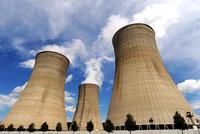-
Urban man-made drainage may increase risk of flooding
Installing drainage systems in developing towns and cities can cause water to reach rivers more quickly, potentially raising the risk of flooding, say scientists. They suggest that, in some cases, storm drains may do more to increase the risk of flooding than changes in the land surface.
-
-
Towns in northeast U.S. develop adaptation strategies for climate change
In many northeastern towns along the coast of the United States, local officials are attempting to identify and predict the effects of climate change which will occur over the next few decades. “You’re going to feel impacts. It’s a global issue with local effects…We don’t know exactly what’s coming, so let’s plan to be adaptable,” says a leader of a regional climate adaptation project.
-
-
Could devastating floods help Bosnians heal their war wounds?
The violent breakup of Yugoslavia in the 1990s and the subsequent war in Bosnia between 1992 and 1995 took the lives of more than 100,000 Bosnians and left two million homeless. Two decades later those survivors have been forced once again to abandon their homes — this time by floodwaters rather than bullets. The heaviest rainfalls ever recorded in the Balkans have led to catastrophic flooding in Bosnia and Herzegovina. Swelled by weeks of rain, the devastating floodwaters swamped more than 60 percent of the country last month, destroying more than 100,000 homes and displacing around 950,000 citizens. The floods also damaged vital infrastructure, destroyed industrial assets, and killed livestock. It is difficult to find a ray of light in this grim story of disaster, except this: Over the past weeks, media outlets have been flooded with stories and images of bravery, camaraderie, and community spirit where ethnicity suddenly became irrelevant. It remains to be seen how this feeling of camaraderie and community can be harvested to mobilize the people of Bosnia ahead of the general elections in October. Such a movement would have the potential to force corrupted political elites into the corner by draining them of their political capital.
-
-
Smart infrastructure sensors are powered by the pavement, bridges they monitor

As states look to improve its infrastructure — roads and bridges — researchers think they may have one solution. They are creating smart infrastructure sensors that are powered by the pavement and bridges they are designed to monitor. These small sensors will self-diagnose damage and mechanical failure in pavements and bridges.
-
-
Carbon-cutting regulations may boost prospects of nuclear power plants

In a report issued last Thursday, Standard & Poor’s Ratings Services (S&P) predicted that new nuclear plant construction could benefit from the Environmental Protection Agency’s (EPA) recent carbon-cutting guidelines for current natural gas power plants.
-
-
IT security at U.S. ports weak: GAO
The Government Accountability Office (GAO) reports that maritime security policies and plans at three high-risk U.S. ports do not effectively address how to assess, manage, and respond to cybersecurity threats. While all three ports have strategies to deal with physical security, there were few policies that specifically addressed cybersecurity.
-
-
Debate continues over controversial lawsuit-killing Louisiana oil bill
Governor Bobby Jindal (R-Louisiana) is facing a difficult decision over whether or not to veto a measure which would kill a contentious lawsuit filed by the Southeast Louisiana Flood Protection Authority-East (SLFPA-E) against ninety-seven different oil and gas companies regarding long-term environmental damage claims, including those of the 2010 Deepwater Horizon explosion.
-
-
NNSA says security at Y-12 National Security Complex has improved
Retired Air Force lieutenant-general and now National Nuclear Security Administration(NNSA) chief Frank Klotz asserted last week that security at the Y-12 National Security Complexat Oak Ridge National Laboratory(ORNL) has improved significantly since a 28 July 2012 break-inat the plant when three aging peace activists, led by an 82-year old nun, managed to breach the facility’s supposedly impregnable perimeter security systems.
-
-
Recession-related cost measures blamed for U.S. infrastructure lagging development
In an alarming fall, the United States is currently ranked 19th in the quality of its infrastructure, according to the World Economic Forum’s Global Competitiveness Report. Additionally, the American Society for Civil Engineers (ASCE) has given the country a D+ on its annual Infrastructure Report Card, arguing that $3.6 trillion is needed by 2020 for maintenance and upgrades.
-
-
Connecticut preparing for sea level rise, adapting to climate change

Earlier this year the University of Connecticut announced the creation of the Institute for Community Resiliency and Climate Adaptation. the Institute is designed to increase the resilience and sustainability of vulnerable communities and individuals along Connecticut’s coast and inland waterways as they are affected by the growing impact of climate change on the environment.
-
-
Connecting dead ends increases power grid stability
Climate change mitigation strategies such as the German Energiewende – the post-Fukushima German policy of phasing out nuclear power — require linking vast numbers of new power generation facilities to the grid. As the input from many renewable sources is rather volatile, depending on how much the wind blows or the sun shines, there is a higher risk of local power instabilities and eventually blackouts. Scientists now employed a novel concept from nonlinear systems analysis called basin stability to tackle this challenge.
-
-
Six more bugs found in popular OpenSSL security tool
OpenSSL is a security tool that provides facilities to other computer programs to communicate securely over the public Internet. OpenSSL is also used in some common consumer applications, such as software in Google’s Android smartphones. So when the Heartbleed vulnerability in OpenSSL was discovered and widely publicized in April this year, system administrators had to rush to update their systems to protect against it. Computer system administrators around the world are groaning again as six new security problems have been found in the OpenSSL security library.
-
-
Security guard industry lacks standards, training

Despite playing a more important role in the wake of 9/11, the security guard industry remains plagued by inadequate training and standards in many states, new study of the $7 billion-a-year industry finds. Formal training of the nation’s one million-plus private security officers is widely neglected, a surprising finding when contrasted with other private occupations such as paramedics, childcare workers, and even cosmetologists.
-
-
Nationwide effort launched to weather-harden Canadian cities
The frequency and magnitude of extreme weather events in Canada — from the floods in Southern Alberta and Toronto to the December ice storm in Central and Eastern Canada — are increasing, causing billions of dollars in damage to infrastructure, businesses and homeowners. Intact Financial Corporation and the University of Waterloo announced a national initiative involving the implementation of twenty climate change adaptation projects designed to reduce the physical, financial, and social impacts of extreme weather events in Canada.
-
-
It is almost certain there are aliens out there, but can we find the money to find them?

UC Berkley Professor Dan Werthimer last month updated members of the House Subcommittee on Science, Space and Technology on the search for extraterrestrial life, and provided a generally upbeat evaluation: ET microbial life likely is ubiquitous throughout the galaxy, and new technologies have improved the chances of detecting signals from advanced alien civilizations.
-
More headlines
The long view
Water Wars: A Historic Agreement Between Mexico and US Is Ramping Up Border Tension
As climate change drives rising temperatures and changes in rainfall, Mexico and the US are in the middle of a conflict over water, putting an additional strain on their relationship. Partly due to constant droughts, Mexico has struggled to maintain its water deliveries for much of the last 25 years, deliveries to which it is obligated by a 1944 water-sharing agreement between the two countries.
Trump Is Fast-Tracking New Coal Mines — Even When They Don’t Make Economic Sense
In Appalachian Tennessee, mines shut down and couldn’t pay their debts. Now a new one is opening under the guise of an “energy emergency.”
Smaller Nuclear Reactors Spark Renewed Interest in a Once-Shunned Energy Source
In the past two years, half the states have taken action to promote nuclear power, from creating nuclear task forces to integrating nuclear into long-term energy plans.
Keeping the Lights on with Nuclear Waste: Radiochemistry Transforms Nuclear Waste into Strategic Materials
How UNLV radiochemistry is pioneering the future of energy in the Southwest by salvaging strategic materials from nuclear dumps –and making it safe.
Model Predicts Long-Term Effects of Nuclear Waste on Underground Disposal Systems
The simulations matched results from an underground lab experiment in Switzerland, suggesting modeling could be used to validate the safety of nuclear disposal sites.
